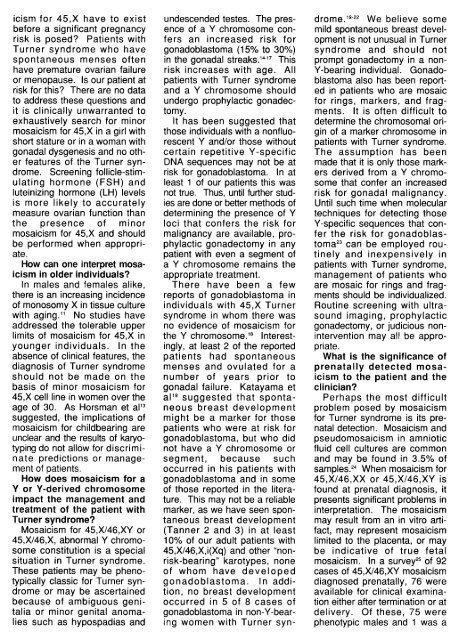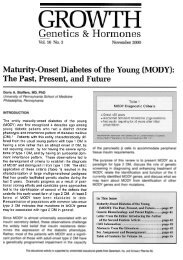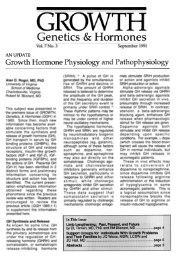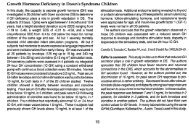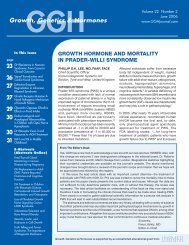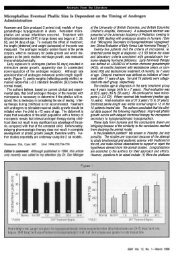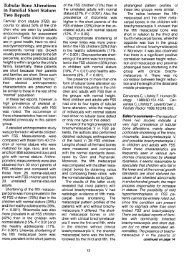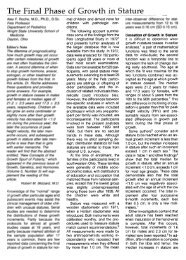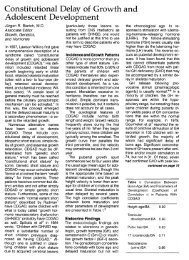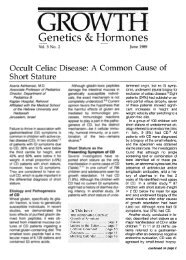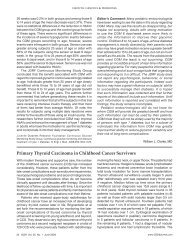Mosaicism in Turner Syndrome - GGH Journal
Mosaicism in Turner Syndrome - GGH Journal
Mosaicism in Turner Syndrome - GGH Journal
You also want an ePaper? Increase the reach of your titles
YUMPU automatically turns print PDFs into web optimized ePapers that Google loves.
icism for 45,X have to exist<br />
before a significant pregnancy<br />
risk is posed? Patients with<br />
<strong>Turner</strong> syndrome who have<br />
spontaneous menses often<br />
have premature ovarian failure<br />
or menopause. Is our patient at<br />
risk for this? There are no data<br />
to address these questions and<br />
it is cl<strong>in</strong>ically unwarranted to<br />
exhaustively search for m<strong>in</strong>or<br />
mosaicism for 45,X <strong>in</strong> a girl with<br />
short stature or <strong>in</strong> a woman with<br />
gonadal dysgenesis and no other<br />
features of the <strong>Turner</strong> syndrome.<br />
Screen<strong>in</strong>g follicle-stimulat<strong>in</strong>g<br />
hormone (FSH) and<br />
lute<strong>in</strong>iz<strong>in</strong>g hormone (LH) levels<br />
is more likely to accurately<br />
measure ovarian function than<br />
the presence of m<strong>in</strong>or<br />
mosaicism for 45,X and should<br />
be performed when appropriate.<br />
How can one <strong>in</strong>terpret mosaicism<br />
<strong>in</strong> older <strong>in</strong>dividuals?<br />
In males and females alike,<br />
there is an <strong>in</strong>creas<strong>in</strong>g <strong>in</strong>cidence<br />
of monosomy X <strong>in</strong> tissue culture<br />
with ag<strong>in</strong>g.11 No studies have<br />
addressed the tolerable upper<br />
limits of mosaicism for 45,X <strong>in</strong><br />
younger <strong>in</strong>dividuals. In the<br />
absence of cl<strong>in</strong>ical features, the<br />
diagnosis of <strong>Turner</strong> syndrome<br />
should not be made on the<br />
basis of m<strong>in</strong>or mosaicism for<br />
45,X cell l<strong>in</strong>e <strong>in</strong> women over the<br />
age of 30. As Horsman et al13<br />
suggested, the implications of<br />
mosaicism for childbear<strong>in</strong>g are<br />
unclear and the results of karyotyp<strong>in</strong>g<br />
do not allow for discrim<strong>in</strong>ate<br />
predictions or management<br />
of patients.<br />
How does mosaicism for a<br />
V or V-derived chromosome<br />
impact the management and<br />
treatment of the patient with<br />
<strong>Turner</strong> syndrome?<br />
<strong>Mosaicism</strong> for 45,X/46,XV or<br />
45,X/46,X, abnormal V chromosome<br />
constitution is a special<br />
situation <strong>in</strong> <strong>Turner</strong> syndrome.<br />
These patients may be phenotypically<br />
classic for <strong>Turner</strong> syndrome<br />
or may be ascerta<strong>in</strong>ed<br />
because of ambiguous genitalia<br />
or m<strong>in</strong>or genital anomalies<br />
such as hypospadias and<br />
undescended testes. The presence<br />
drome.19-22 We believe some<br />
of a Y chromosome con-<br />
mild spontaneous breast develdrome.19-22<br />
fers an <strong>in</strong>creased risk for opment is not unusual <strong>in</strong> <strong>Turner</strong><br />
gonadoblastoma (15% to 30%) syndrome and should not<br />
<strong>in</strong> the gonadal streaks.14-17 This prompt gonadectomy <strong>in</strong> a nonrisk<br />
<strong>in</strong>creases with age. All V-bear<strong>in</strong>g <strong>in</strong>dividual. Gonadoblastoma<br />
patients with <strong>Turner</strong> syndrome<br />
also has been report-<br />
and a Y chromosome should ed <strong>in</strong> patients who are mosaic<br />
undergo prophylactic gonadectomyments.<br />
for r<strong>in</strong>gs, markers, and frag-<br />
It is often difficult to<br />
It has been suggested that determ<strong>in</strong>e the chromosomal orig<strong>in</strong><br />
those <strong>in</strong>dividuals with a nonfluorescent<br />
of a marker chromosome <strong>in</strong><br />
Y and/or those without patients with <strong>Turner</strong> syndrome.<br />
certa<strong>in</strong> repetitive Y -specific The assumption has been<br />
DNA sequences may not be at made that it is only those markers<br />
risk for gonadoblastoma, In at<br />
derived from a Y chromo-<br />
least 1 of our patients this was some that confer an <strong>in</strong>creased<br />
not true. Thus, until further studies<br />
risk for gonadal malignancy.<br />
are done or better methods of Until such time when molecular<br />
determ<strong>in</strong><strong>in</strong>g the presence of Y techniques for detect<strong>in</strong>g those<br />
loci that confers the risk for Y -specific sequences that confer<br />
malignancy are available, prophylactic<br />
the risk for gonadoblas-<br />
gonadectomy <strong>in</strong> any toma23 can be employed rout<strong>in</strong>ely<br />
patient with even a segment of<br />
and <strong>in</strong>expensively <strong>in</strong><br />
a Y chromosome rema<strong>in</strong>s the patients with <strong>Turner</strong> syndrome,<br />
appropriate treatment.<br />
management of patients who<br />
There have been a few are mosaic for r<strong>in</strong>gs and fragments<br />
reports of gonadoblastoma <strong>in</strong><br />
should be <strong>in</strong>dividualized.<br />
<strong>in</strong>dividuals with 45,X <strong>Turner</strong> Rout<strong>in</strong>e screen<strong>in</strong>g with ultrasound<br />
syndrome <strong>in</strong> whom there was<br />
imag<strong>in</strong>g, prophylactic<br />
no evidence of mosaicism for gonadectomy, or judicious non<strong>in</strong>tervention<br />
the Y chromosome.18 Interest<strong>in</strong>gly,<br />
may all be appro-<br />
at least 2 of the reported priate.<br />
patients had spontaneous What is the significance of<br />
menses and ovulated for a prenatally detected mosaicism<br />
number of years prior to<br />
to the patient and the<br />
gonadal failure. Katayama et cl<strong>in</strong>ician?<br />
al18 suggested that spontaneous<br />
Perhaps the most difficult<br />
breast development problem posed by mosaicism<br />
might be a marker for those for <strong>Turner</strong> syndrome is its prenatal<br />
patients who were at risk for<br />
detection. <strong>Mosaicism</strong> and<br />
gonadoblastoma, but who did pseudo mosaicism <strong>in</strong> amniotic<br />
not have a Y chromosome or fluid cell cultures are common<br />
segment, because such and may be found <strong>in</strong> 3.5% of<br />
occurred <strong>in</strong> his patients with samples.24 When mosaicism for<br />
gonadoblastoma and <strong>in</strong> some 45,X/46,XX or 45,X/46,XY is<br />
of those reported <strong>in</strong> the litera-ture. found at prenatal diagnosis, it<br />
This may not be a reliable presents significant problems <strong>in</strong><br />
marker, as we have seen spontaneous<br />
<strong>in</strong>terpretation. The mosaicism<br />
breast development may result from an <strong>in</strong> vitro arti-<br />
(Tanner 2 and 3) <strong>in</strong> at least fact, may represent mosaicism<br />
10% of our adult patients with limited to the placenta, or may<br />
45,X/46,X,i(Xq) and other "nonrisk-bear<strong>in</strong>g"<br />
be <strong>in</strong>dicative of true fetal<br />
karotypes, none mosaicism. In a survey25 of 92<br />
of whom have developed cases of 45,X/46,XY mosaicism<br />
gonadoblastoma. In addi-tion, diagnosed prenatally, 76 were<br />
no breast development available for cl<strong>in</strong>ical exam<strong>in</strong>ation<br />
occurred <strong>in</strong> 5 of 8 cases of<br />
either after term<strong>in</strong>ation or at<br />
gonadoblastoma <strong>in</strong> non- Y -bear<strong>in</strong>g<br />
delivery. Of these, 75 were<br />
women with <strong>Turner</strong> syn-<br />
phenotypic males and 1 was<br />
a


